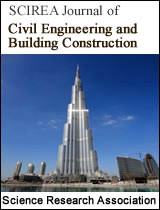Inventory of building projects in the semi-formal sector in the Republic of Congo.
DOI: 10.54647/cebc560131 66 Downloads 43919 Views
Author(s)
Abstract
The growing concern for housing in developing countries, where the need for housing far exceeds the supply offered by the public authorities, has encouraged the development and growth of self-construction in towns and cities. It is with this in mind that the informal and semi-informal sectors are being called upon by property developers wishing to study and carry out their projects according to the means available to them. The survey conducted in the semi-informal sector in the Republic of Congo confirms the existence of shortcomings in the management of construction projects in developing countries. Contractors, engineers and architects are at the heart of most residential construction projects. Most projects are financed by the property developers' own funds. Labour productivity on building sites varies from one project to another, and delays in delivery caused by poor project planning, scarcity of financial resources or poor project management are often recorded.
Keywords
Construction, semi-informal sector, planning, project, management.
Cite this paper
Destin Gemetone ETOU, Sylvain NDINGA OKINA, Alain Symphorien NDONGO, Christian TATHY,
Inventory of building projects in the semi-formal sector in the Republic of Congo.
, SCIREA Journal of Civil Engineering and Building Construction .
Volume 8, Issue 3, June 2023 | PP. 120-133.
10.54647/cebc560131
References
| [ 1 ] | Destin Gemetone Etou, Christian Tathy, Sorel Gaël Dzaba-Dzoualou, Rodrigue Armel Patrick Okemba, Narcisse Malanda, Paul Louzolo-Kimbembe. The dysfunctions of construction project management in developing countries: The case of the Republic of Congo. American Journal of Engineering Research (AJER), Vol-10 (12) -issue-12-2021, p.202-207. |
| [ 2 ] | Lachambre M. Plaidoyer pour un NEPAD "Logement" en Afrique, Villes en Développement, Bulletin de la Coopération française pour le développement urbain, l'habitat et l'aménagement spatial, No. 56, June 2002, p. 6-7. |
| [ 3 ] | Delis Philippe, Girard Christian, De Maximy René et al. Economie de la construction à Kinshasa, Paris: L'Harmattan, 1988, 125 p. |
| [ 4 ] | Blondin P., Mouna Kigue D., Vothanh T. Typologie et coût de construction à Douala, Centre d'Edition et de Production pour l'Enseignement et la Recherche, 1988, Yaoundé, Cameroon. |
| [ 5 ] | Pettang C. Éléments d'optimisation de la production d'un habitat urbain au Cameroun, Presses Universitaires de Yaoundé, 1999, 183 p. |
| [ 6 ] | Louzolo-Mimbembe Paul, Contribution aux méthodes de maîtrise du coût de la construction daans les pays en développement : estimation du coût et optimisation dans un contexte hors délai, PhD thesis, Ecole Polytechnique de Yaoundé (Cameroon), February 2005 304p. |
| [ 7 ] | Sonia Menguelti, Cécile Perret, Belaïd Abrika, A la croisée du formel et de l'informel : les entreprises créées par le dispositif de l'Agence Nationale de Soutien à l'emploi des jeunes dans le Wilaya de Tizi-Ouzou, 2014. |
| [ 8 ] | Pierre Bréchon, Échantillon aléatoire, échantillon par quotas : les enseignements de l'enquête EVS 2008 en France. Presentation at the Francophone Conference on Surveys, Tangiers, March 2010. |
| [ 9 ] | Séraphin Mouzoun, Ecologie et connaissances ethnozoologiques du porc-épic à crête (Hystrix cristata linnaeus, 1758) dans les réserves de biosphère de la pendjari et du W du Bénin. Zoologie des vertèbres, University of Abomey-Calavi (Benin); 2018. |

